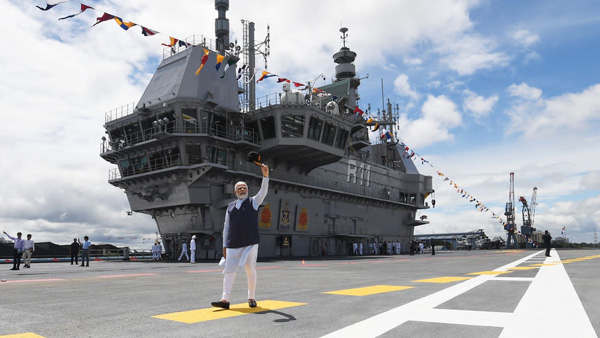The year 2022 has been quite eventful for Indian Navy – however among the various accomplishments of Navy this year, one stands out as the most significant – commissioning of INS Vikrant. This addition to the naval fleet signals not only the growing prowess of Indian shipbuilding and manufacturing industry, but most importantly it adds a layer of strategic-security. But as is true with all things of significance, INS Vikrant’s induction too comes with some very animated discussions.
INS Vikrant, the Original Beast
For any Indian with even a remote interest in defence and security, it’s impossible to not be familiar with India’s first aircraft carrier, a Majestic-class ship purchased from the British and christened INS Vikrant.
The aircraft carrier saw major action during the 1971 Bangladesh Liberation War where it ensured successful blockade of East Pakistan, thereby preventing the mass escape of Pakistan army and a successful capture of 93000 POWs. Proving its worth as an outstanding asset that wasn’t only effective in a combined tri-service campaign but was significant in providing mobility and access, the original INS Vikrant sealed India’s position as a mighty naval power of the Indian Ocean Region.
India’s First Indigenous Aircraft Carrier – INS Vikrant version 2.0
As a tribute to the previous/original INS Vikrant, the Indian Navy commissioned the country’s first ever indigenous aircraft carrier with the same name and motto as the predecessor. The new INS Vikrant will strengthen the country’s standing as a ‘Blue Water Navy’ — a maritime force with global reach and capability to operate over deep seas…She will be the proverbial spear, whose shining tip is her package of fighter aircraft that operate from its deck for various offensive missions.
The induction and reincarnation of Vikrant is not only another step towards strengthening our defence preparedness, but also our humble tribute to the sacrifices made by our freedom fighters for the Independence of the nation and our brave soldiers during the 1971 war.
– Indian Navy
As is the case in any democracy, the entry of Vikrant into active service has been accompanied by some debates. One such vigorous discussions is about which fighter will India and her Navy select as an interim arrangement to fly from the deck of INS Vikrant – the French Rafale or the American F18 E/F Hornets. And while the discussions are part of a healthy democracy, one thing is for certain – the Indian Navy urgently requires fighter aircraft to operate from INS Vikrant.
Quest for an Indigenous Fighter Aircraft
The Indian Navy’s quest for an indigenous fighter aircraft goes back to 1986 when the Navy had sought concurrent development of a naval fighter aircraft along with the IAF programme as a replacement for the Sea Harriers by 2005. This has a precedence. If we see all successful deck-based aircraft around the world such as F-4, F-14, F-18, Rafale and F-35, they were first designed for the Navy and then modified for shore-based operations and not vice-versa. (MiG 29K is the only aircraft converted from a shore-based MiG 29B.) However, since feasibility to develop a fighter aircraft exclusively for the Navy was ruled out due to the small numbers, the Navy agreed to consider the Light Combat Aircraft (LCA), which were originally being developed for the Air Force. With an understanding that the LCA would meet Navy’s qualitative requirements – like the wing design, identifying a suitable engine etc., the Navy has been actively supporting the N-LCA programme (Naval LCA programme) and has contributed not just a lion’s share of the cost but also provided specialised pilots for the programme. These mandatory customisations will need thorough research and development, but they promise successful and effective sorties and will also ensure the safety of naval personnel onboard. But unfortunately, this comes at a cost – the necessary customisations were not able to meet the Indian Navy’s immediate requirement within the envisaged time frames. The Navy is left with no choice but to look for foreign procurement to meet the immediate threat from our adversaries.Also Read:INS Vikrant – All You Need to Know
Foreign Procurement – Interim Answer to Navy’s Aircraft Shortage
Amidst the growing security challenges from China, who are now the largest and most rapidly expanding navy in the world, INS Vikrant gives a much-needed boost to our defense ecosystem. After commissioning in September this year, the carrier is expected to shortly commence air operations. However, with the LCA under customization, the Navy was left with two choices – either wait for the N-LCA to be inducted by 2032 and let Vikrant sail without fighter aircraft or induct few foreign aircrafts till the LCA’s are in operation.The Indian Navy chose the smart option – to fill the gap, Navy has decided to procure 26 foreign aircrafts to keep Vikrant combat ready. As per reports these will be either Boeing-manufactured F/A-18 Super Hornets or the Dassault-manufactured Rafale M fighter aircraft, both of which have been shortlisted after years of technical evaluation and operational demonstration for suitability of operating on our indigenous carrier. Either way, this decision gives adequate time for development of the indigenous LCA (Navy) while ensures that Vikrant is ready and trained for combat. It is often debated but widely agreed that an aircraft carrier is a military tool of tremendous operational capabilities, which can provide a country with military and diplomatic edge. While expensive to buy, it is ultimately less expensive and far more flexible (both militarily and politically) than deploying and sustaining land-based air assets to an available friendly host nation, and therefore well worth the investment. For a maritime country like like India, INS Vikrant when fully operational will not only be a proof of India’s technological proficiency but like its predecessor it will be a lethal weapon that every adversary would fear.

